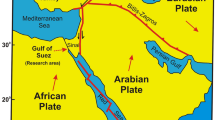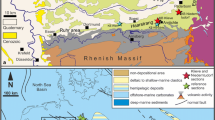Abstract
The facies development and onlap pattern of the lower Danubian Cretaceous Group (Bavaria, southern Germany) have been evaluated based on detailed logging, subdivision, and correlation of four key sections using an integrated stratigraphic approach as well as litho-, bio-, and microfacies analyses. Contrary to statements in the literature, the transgressive onlap of the Regensburg Formation started in the Regensburg–Kelheim area already in the early Early Cenomanian Mantelliceras mantelli ammonite Zone and not in the Late Cenomanian. In the Early Cenomanian, nearshore glauconitic-bioclastic sandstones prevailed (Saal Member), followed by Middle to lower Upper Cenomanian mid-shelf siliceous carbonates intercalated with fine-sandy to silty marls (Bad Abbach Member). Starting in the mid-Late Cenomanian (Metoicoceras geslinianum ammonite Zone), a considerable deepening pulse during the Cenomanian–Turonian Boundary Event (CTBE) initiated the deposition of the deeper shelf silty marls of the Eibrunn Formation, which range into the early Early Turonian. During the CTBE transgression, also the proximal Bodenwöhrer Senke (ca. 40 km NE of Regensburg) was flooded, indicated by the onlap of the Regensburg Formation onto Variscan granites of the Bohemian Massif, overlain by a thin tongue of lowermost Turonian Eibrunn Formation. A detailed record of the positive δ13C excursion of the global Oceanic Anoxic Event (OAE) 2 has been retrieved from this shallow-water setting. An integrated approach of bio-, event-, carbon stable isotope and sequence stratigraphy was applied to correlate the sections and to decipher the dynamics of this overall transgressive depositional system. The Cenomanian successions show five prominent unconformities, which correlate with those being known from basins in Europe and elsewhere, indicating their eustatic origin. The rate of sea-level rise during the CTBE suggests glacio-eustasy as a driving mechanism for Late Cenomanian sea-level changes. The Regensburg and Eibrunn formations of the lower Danubian Cretaceous Group are highly diachronous lithostratigraphic units. Their regional distribution and northeast-directed onlap pattern onto the southwestern margin of the Bohemian Massif can readily be explained by the lateral movements of roughly coast-parallel (i.e., NW/SE-trending) facies belts of a graded shelf system transgressing on a northeastward-rising substrate. It took the Cenomanian coastline ca. 6 Ma to transgress from southwest of Regensburg to the topographically elevated granite cliffs southeast of Roding in the Bodenwöhrer Senke (=60 km distance).













Similar content being viewed by others
References
Borota S (2007) Sedimentologisch-stratigraphische Untersuchungen der danubischen Unter- bis tieferen Oberkreide an den Profilen Bad Abbach und Saal an der Donau. Diploma thesis, Würzburg University, p 101 [Unpubl.]
Carson GA, Crowley SF (1993) The glauconite-phosphate association in hardgrounds: examples from the Cenomanian of Devon, southwest England. Cret Res 14:69–89
Chellouche P (2008) Land–Küste–Meer: Stratigraphie, Paläontologie und Sedimentologie der Danubischen Kreide-Gruppe in der östlichen Bodenwöhrer Senke (Oberpfalz, Bayern). Diploma thesis, Würzburg University, p 104 [Unpubl.]
Coe AL (2003) The sedimentary record of sea-level change. University Press, Cambridge, p 288
Dacqué E (1939) Die Fauna der Regensburg–Kehlheimer Oberkreide (mit Ausschluss der Spongien und Bryozoen). Abh Bayer Akad Wiss, Math Naturwiss Abt NF 45:1–218
Ernst G, Schmid F, Seibertz E (1983) Event-Stratigraphie im Cenoman und Turon von NW-Deutschland. Zitteliana 10:531–554
Ernst G, Niebuhr B, Wiese F, Wilmsen M (1996) Facies development basin dynamics event correlation and sedimentary cycles in the Upper Cretaceous of selected areas of Germany and Spain. In: Reitner J, Neuweiler F, Gunkel F (eds) Global and regional controls on biogenic sedimentation. II. Cretaceous sedimentation. Research reports. Göttinger Arb Geol Paläont Sb 3:87–100
Förster R, Meyer R, Risch H (1983) Ammoniten und planktonische Foraminiferen aus den Eibrunner Mergeln (Regensburger Kreide, Nordostbayern). Zitteliana 10:123–141
Gale AS (1995) Cyclostratigraphy and correlation of the Cenomanian stage in Western Europe. In: House MR, Gale AS (eds) Orbital forcing timescales and cyclostratigraphy. Geol Soc Spec Publ Lond 85:177–197
Gradstein FM, Ogg JG, Smith AG (2004) A geologic time scale 2004. University Press, Cambridge, p 589
Hallam A (1992) Phanerozoic sea-level changes. Columbia University Press, New York, p 266
Hancock JM, Kauffman EG (1979) The great transgressions of the Late Cretaceous. J Geol Soc Lond 136:175–186
Hardenbol J, Thierry J, Farley MB, Jaquin T, de Graciansky P, Vail PR (1998) Mesozoic and Cenozoic sequence chronostratigraphic framework of European basins chart 4: Cretaceous sequence chronostratigraphy. In: de Graciansky P, Hardenbol J, Jaquin T, Vail PR (eds) Mesozoic and Cenozoic sequence stratigraphy of European basins. SEPM Spec Publ 60
Hilbrecht H (1986) Die Turon-Basis im Regensburger Raum: Inoceramen, Foraminiferen und “events” der Eibrunner Mergel bei Bad Abbach. N Jb Geol Paläont Abh 172:71–82
Hilbrecht H, Hoefs J (1986) Geochemical and palaeontological studies of the δ13C anomaly in the boreal and north Tethyan Cenomanian-Turonian sediments in Germany and adjacent areas. Palaeogeogr Palaeoclimatol Palaeoecol 53:169–189
Hilbrecht H, Frieg C, Tröger K-A, Voigt S, Voigt T (1996) Shallow water facies during the Cenomanian–Turonian anoxic event: bio-events, isotopes, and sea level in southern Germany. Cret Res 17:229–253
Immenhauser A (2005) High-rate sea-level change during the Mesozoic: new approaches to an old problem. Sed Geol 175:277–296
Jarvis I, Gale AS, Jenkyns HC, Pearce MA (2006) Secular variation in Late Cretaceous carbon isotopes: a new δ13C carbonate reference curve for the Cenomanian–Campanian (99.6–70.6 Ma). Geol Mag 143:561–608
Kauffman EG, Herm D, Johnson CC, Harries P, Höfling R (2000) The ecology of Cenomanian lithistid sponge frameworks, Regensburg area, Germany. Lethaia 35:214–235
Meyer RKF (2000) Außeralpine Kreide in Süddeutschland (Regensburger Kreide). In: Stratigraphische Kommission Deutschland (ed) Stratigraphie von Deutschland III. Die Kreide der Bundesrepublik Deutschland. Courier Forsch Senckenberg 226:141–147
Miller KG, Kominz MA, Browning JV, Wright JD, Mountain GS, Katz ME, Sugarman PJ, Cramer BS, Christie-Blick N, Pekar SF (2005) The Phanerozoic record of global sea-level change. Science 310:1293–1298
Mitchell SF, Paul CRC, Gale AS (1996) Carbon isotopes and sequence stratigraphy. In: Howell JA, Aitken JF (eds) High-resolution sequence stratigraphy: Innovations and applications. Geol Soc Spec Publ Lond 104:11–24
Niebuhr B (2008) Profilaufnahme der Kreide-Sedimente des ehemaligen Steinbruches Obertrübenbach südöstlich von Roding, Oberpfalz. Int Rep, Bayerisches Landesamt für Umwelt, Marktredwitz, p 19 [Unpubl.]
Niebuhr B, Pürner T, Wilmsen M (2009) Lithostratigraphie der außeralpinen Kreide Bayerns. SDGG 65:7–58
Pitman WC III, Golovchenko X (1983) The effects of sea-level change on the shelfedge and slope of passive margins. In: Stanley DJ, Moore GT (eds) The shelf break: critical interface on continental margins. SEPM Spec Publ 33:41–58
Risch H (1983) Zur Mikrobiostratigraphie der Regensburger Kreide. Zitteliana 10:143–153
Robaszynski F, Hardenbol J, Caron M, Amédro F, Dupuis C, Gonzales Donoso JM, Linares D, Gartner S (1993) Sequence stratigraphy in a distal environment: the Cenomanian of the Kalaat Senan region (central Tunisia). Bull Centres Rech Explor Prod Elf Aquitaine 17:395–433
Robaszynski F, Juignet P, Gale AS, Amédro F, Hardenbol J (1998) Sequence stratigraphy in the Cretaceous of the Anglo-Paris Basin, exemplified by the Cenomanian stage. In: Jaquin T, Graciansky de P, Hardenbol J (eds) Mesozoic and Cenozoic sequence stratigraphy of European basins. SEPM Spec Publ 60:363–385
Röper M, Rothgaenger M (1995) Neue Fossilfunde aus der Regensburger Oberkreide. Teil 1: Eibrunner Mergel. Fossilien 3(1995):180–184
Sahagian D, Pinous O, Olferiev A, Zakharov V (1996) Eustatic curve for the Middle Jurassic-Cretaceous based on Russian Platform and Siberian stratigraphy: zonal resolution. Amer Assoc Petrol Geol Bull 80:1433–1458
Sharland PR, Archer R, Casey DM, Davies RB, Hall SH, Heward AP, Horbury AD, Simmons MD (2001) Arabian Plate sequence stratigraphy. Geoarab Spec Publ 2:1–371
Tröger K-A, Niebuhr B, Wilmsen M (2009) Inoceramen aus dem Cenomanium bis Coniacium der Danubischen Kreide-Gruppe (Bayern, Süd-Deutschland). SDGG 65:59–110
Trusheim F (1935) Die geologische Geschichte Südostdeutschlands während der Unterkreide und des Cenomans. N Jb Min B 75:1–109
Ulicný D, Hladíková J, Hradecká L (1993) Record of sea-level changes, oxygen depletion and the δ13C anomaly across the Cenomanian–Turonian boundary, Bohemian Cretaceous Basin. Cret Res 14:211–234
Voigt S, Gale AS, Voigt T (2006) Sea-level changes, carbon cycling and palaeoclimate during the Late Cenomanian of northwest Europe; an integrated palaeoenvironmental analysis. Cret Res 27:836–858
Voigt S, Aurag A, Leis F, Kaplan U (2007) Late Cenomanian to Middle Turonian high-resolution carbon isotope stratigraphy: new data from the Münsterland Cretaceous Basin, Germany. Earth Planet Sci Lett 252:196–210
Voigt S, Erbacher J, Mutterlose J, Weiss W, Westerhold T, Wiese F, Wilmsen M, Wonik T (2008) The Cenomanian–Turonian of the Wunstorf section (North Germany): global stratigraphic reference section and new orbital time scale for Oceanic Anoxic Event 2. Newsl Strat 43:65–89
Wachter E, Hayes JM (1985) Exchange of oxygen isotopes in carbon-dioxide—phosphoric acid systems. Chem Geol 52:365–374
Wiese F, Košták M, Wood CJ (2009) The Upper Cretaceous belemnite Preaactinocamax plenus (Blainville, 1827) from Lower Saxony (Upper Cenomanian, northwest Germany) and its distribution pattern in Europe. Paläont Z 83:309–321
Wilmsen M (2003) Sequence stratigraphy and palaeoceanography of the Cenomanian Stage in northern Germany. Cret Res 24:525–568
Wilmsen M (2007) Integrated stratigraphy of the upper Lower–lower Middle Cenomanian of northern Germany and southern England. Acta Geol Polon 57:263–279
Wilmsen M (2008) An Early Cenomanian (Late Cretaceous) maximum flooding bioevent in NW Europe: correlation, sedimentology and biofacies. Palaeogeogr Palaeoclimatol Palaeoecol 258:317–333
Wilmsen M, Niebuhr B (2002) Stratigraphic revision of the upper Lower and Middle Cenomanian in the Lower Saxony Basin (northern Germany) with special reference to the Salzgitter area. Cret Res 23:445–460
Wilmsen M, Niebuhr B (2010) On the age of the Upper Cretaceous transgression between. Regensburg and Neuburg an der Donau (Bavaria, southern Germany). N Jb Geol Paläont 256:267–278
Wilmsen M, Rabe M (2008) Belemnites from the lower Middle Cenomanian of Hoppenstedt, northern Germany: significance and integrated correlation. Cret Res 29:936–942
Wilmsen M, Wood CJ (2004) The Cenomanian of Hoppenstedt, northern Germany—a Subhercynian key section revisited. Newl Strat 40:209–230
Wilmsen M, Niebuhr B, Wood CJ, Zawischa D (2007) Fauna and palaeoecology of the Middle Cenomanian Praeactinocamax primus Event at the type locality, Wunstorf quarry, northern Germany. Cret Res 28:428–460
Wilmsen M, Wood CJ, Niebuhr B, Kaplan U (2009a) Cenomanian–Coniacian ammonoids of the Danubian Cretaceous Group (Bavaria, southern Germany). SDGG 65:111–124
Wilmsen M, Niebuhr B, Voigt T (2009b) Sequence stratigraphy of the Elbtal and Danubian Cretaceous Groups (Germany): tentative Cenomanian–Turonian correlations across the Bohemian Massif. SDGG 63:218–219
Wilmsen M, Niebuhr B, Chellouche P (2010) Occurrence and significance of Cenomanian belemnites in the lower Danubian Cretaceous Group (Bavaria, southern Germany). Acta Geol Polon 60:231–241
Ziegler PA (1990) Geological atlas of Western and Central Europe, 2nd edn. Shell Intern. Petrol., Maatschappij B.V, pp 1–239
Acknowledgments
The paper greatly benefited from insightful reviews by R. Henrich (Bremen) and J. Mutterlose (Bochum) as well as editorial comments by A. Freiwald (Wilhelmshaven). We thank U. Heimhofer (Bochum) and P. Hochuli (Zürich) for the identification of the palynomorphs and C. Linnert (Bochum) for the analysis of calcareous nannoplankton from the basal black clay of the Grub section. M. Jäger (Dotternhausen) identified several micro-invertebrates from the Limestone Bed of the Obertrübenbach section. We also acknowledge the permission to access the Saal (Felswerke AG, Saal an der Donau) and the Haimerl quarries (Haimerl gravel works, Grub) for fieldwork. We are indebted to J. Rohrmüller (Bayerisches Landesamt für Umwelt, LfU, Marktredwitz) for the permission to publish data of an internal LfU report (Niebuhr 2008) and his comments on the components of the basal conglomerate of the Regensburg Formation at Obertrübenbach, which was superbly photographed by R. Winkler (Senckenberg Dresden; cf. Fig. 9c). This paper is a contribution to DFG project WI 1743/6-1.
Author information
Authors and Affiliations
Corresponding author
Rights and permissions
About this article
Cite this article
Wilmsen, M., Niebuhr, B., Chellouche, P. et al. Facies pattern and sea-level dynamics of the early Late Cretaceous transgression: a case study from the lower Danubian Cretaceous Group (Bavaria, southern Germany). Facies 56, 483–507 (2010). https://doi.org/10.1007/s10347-010-0224-2
Received:
Accepted:
Published:
Issue Date:
DOI: https://doi.org/10.1007/s10347-010-0224-2




